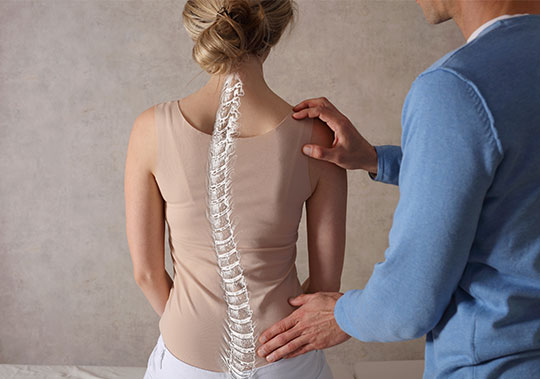Scoliosis Treatment
What is scoliosis?
Scoliosis is a three-dimensional curvature of the spine, in which the spine rotates and bends to become a C or an S shape. Scoliosis affects about 3 percent of the population and is thought to have a genetic component. Most scoliosis is idiopathic, meaning that it is does not have an identifiable cause.
Through a combination of factors, one or more vertebrae in the spine form in a wedged shape. Since bone structure responds to the forces that are applied to the spine, the wedging of the vertebrae creates a cycle—the concave side of the vertebra receives more compressive forces and grows to become more compact, while the convex side of the vertebra receives a relative traction force and grows to be abnormally wide. Scoliosis often progresses (worsens) as a child grows and it is often first noticed when a child goes through a growth spurt, usually at the beginning of puberty. The goal of treatment is to identify the curve early and prevent it from progressing to a more significant spine curvature.
Scoliosis in adults
It is not uncommon for someone to notice scoliosis for the first time as an adult. In some cases this curvature is the result of an undiagnosed adolescent scoliosis that progressed with age. In other cases it occurs due to age-related structural changes that cause shifting of the vertebrae. Adult-onset scoliosis is often noticed during or shortly after pregnancy or menopause. It can appear as an unexplained loss of height, the sensation of one side of the back feeling tighter or less flexible, or noticing that clothing fits differently than before. Fortunately the progression can be slowed or halted, and pain related to adult-onset scoliosis can be addressed with physical therapy.
How can physical therapy help scoliosis?
Physical therapists work as part of a team with pediatricians (in adolescent scoliosis), spine doctors, and possibly orthotists. Since the spine is curved, the muscles, connective tissues, and rib joints on the concave side of the curve become tight. Meanwhile, the muscles on the convex side are overstretched and become weak. These muscle imbalances contribute to poor posture and reinforce the curve pattern, further causing the vertebrae to grow in a wedged shape.
Overall, research has shown scoliosis-specific physical therapy to be very effective in stabilizing or reducing the Cobb angle and improving posture in children and adults with curves up to 45 degrees. PT can be an effective standalone treatment in curves less than 25 degrees. If bracing is required, scoliosis-specific exercises have been shown to significantly improve outcomes when they are added to the bracing program. Whether someone is 10 years old or 100 years old, it is never too late to make changes!
What is the Schroth Method?
The Schroth Method is the gold standard for scoliosis-specific physical therapy. It was developed in the early 1900s by Katharina Schroth, a girl with significant scoliosis who was able to use specific exercises, postural corrections, and breathing patterns to reduce her curvature. As new research has been done and more medical providers have taken an interest in scoliosis, the original Schroth Method has evolved to match our modern understanding of the condition.
Schroth-based PT treatment may include:
– Manual therapy to loosen tight muscles and joints
-Training in three-dimensional postural corrections specific to that person’s curve pattern, practiced so that this corrected posture becomes a habit
-Strengthening in this corrected posture
-Breathing exercises to help de-rotate the spine and ribcage and improve spine alignment
-Body mechanics training to learn how to hold the body in a more aligned position with all the activities of daily life
Scoliosis care at Utah Physical Therapy
We offer Schroth-based physical therapy for all ages at Utah PT. We also offer free scoliosis screenings for children and adolescents.
Duration of a PT episode depends on the curve, the age of the patient, and their motivation to exercise at home. Generally we start with 6-8 weeks of 1-2 PT sessions a week, decreasing the frequency of visits as the patient becomes familiar with the exercises and establishes a good home routine. After this initial episode of care, typically we check in every 6 months to 1 year for a 2-3 visit “refresher” to assess progress and modify the exercises as needed.
